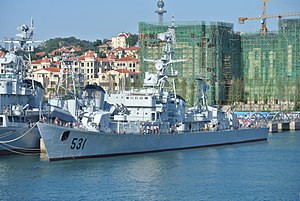Chinese frigate Yingtan (531)
 Yingtan alongside Jinan on 24 August 2017
| |
| History | |
|---|---|
| Name |
|
| Namesake | Yingtan |
| Builder | Zhonghua shipyard, Shanghai |
| Launched | October 1971 |
| Commissioned | March 1975 |
| Decommissioned | July 1994 |
| Identification | Pennant number: 531 |
| Status | Museum ship at , Qingdao |
| General characteristics | |
| Class and type | Type 053K frigate |
| Displacement |
|
| Length | 103.2 m (339 ft) |
| Beam | 10.7 m (35 ft) |
| Propulsion |
|
| Speed | 26 knots |
| Range | 2,700 nmi (5,000 km; 3,100 mi) at 18 knots (33 km/h; 21 mph) |
| Complement | 300 (27 officers) |
| Sensors and processing systems |
|
| Electronic warfare & decoys | Watchdog; Radar warning |
| Armament |
|
Yingtan (531) was a Type 053 frigate of the People's Liberation Army Navy. She is now a museum ship in Qingdao.
Development and design[]
The class have four anti-ship SY-1s in two twin-box launchers, armaments consisted to two single 100mm dual-purpose hand-loaded guns with fire control by a very simple stereoscopic rangefinder, limiting the guns to effective fire against surface targets in daylight/clear weather only. The six twin 37mm short-range anti-aircraft guns were all locally controlled, severely limiting their effectiveness. These ships are equipped with Chinese SJD-3 sonar, which is modification of Soviet Tamir-11 (MG-11, with NATO reporting name Stag Hoof) hull mounted sonar: instead of being fixed to the hull, SJD-3 has a telescoping arm, so when not in use, the sonar is stored in the hull, and when deployed, the sonar is lowered into water several meter below the hull, thus increased detection range by avoiding baffles generated by the hull. 11 Anti-submarine armament was limited to short-range rockets and depth charges. Damage control arrangements were minimal.
From 1965 to 1967, the No. 701 Institute designed the Type 053K (Kong for air-defence), an air-defence variant of the Type 065. This met a PLAN requirement for air-defence ships to accompany the surface-warfare Type 051 destroyers. The Type 053K was originally intended to have three screws powered by a combined gas-turbine and diesel engine, with a speed of 38 knots. However, technical constraints forced the Chinese to settle for a diesel engine, powering two screws for a maximum speed of 30 knots.
The Type 053Ks were armed with HQ-61 surface-to-air missiles, launched from two twin-armed launchers; these did not enter service until the mid-1980s. The 100 mm. gun armament was also delayed. This class received NATO reporting name as Jiangdong class.
Construction and career[]
She was launched in October 1971 at Hudong-Zhonghua Shipyard in Shanghai and commissioned in March 1975.
She was decommissioned in July 1994 and currently she sits at , Qingdao as a museum ship.[1]
Gallery[]

Yingtan in Qingdao on 16 July 2005.

Yingtan in Qingdao on 4 September 2011.

Yingtan in Qingdao on 22 August 2015.

Yingtan in Qingdao on 22 August 2015.

Yingtan in Qingdao on 22 August 2015.
References[]
- ^ "531 鹰潭号护卫舰(退役)-中国护卫舰-武器百科大全". www.wuqibaike.com. Retrieved 2 April 2021.
Coordinates: 36°03′17″N 120°19′16″E / 36.0546303°N 120.3210161°E
- 1971 ships
- Type 053 frigates
- Ships built in China
- Museum ships in China






